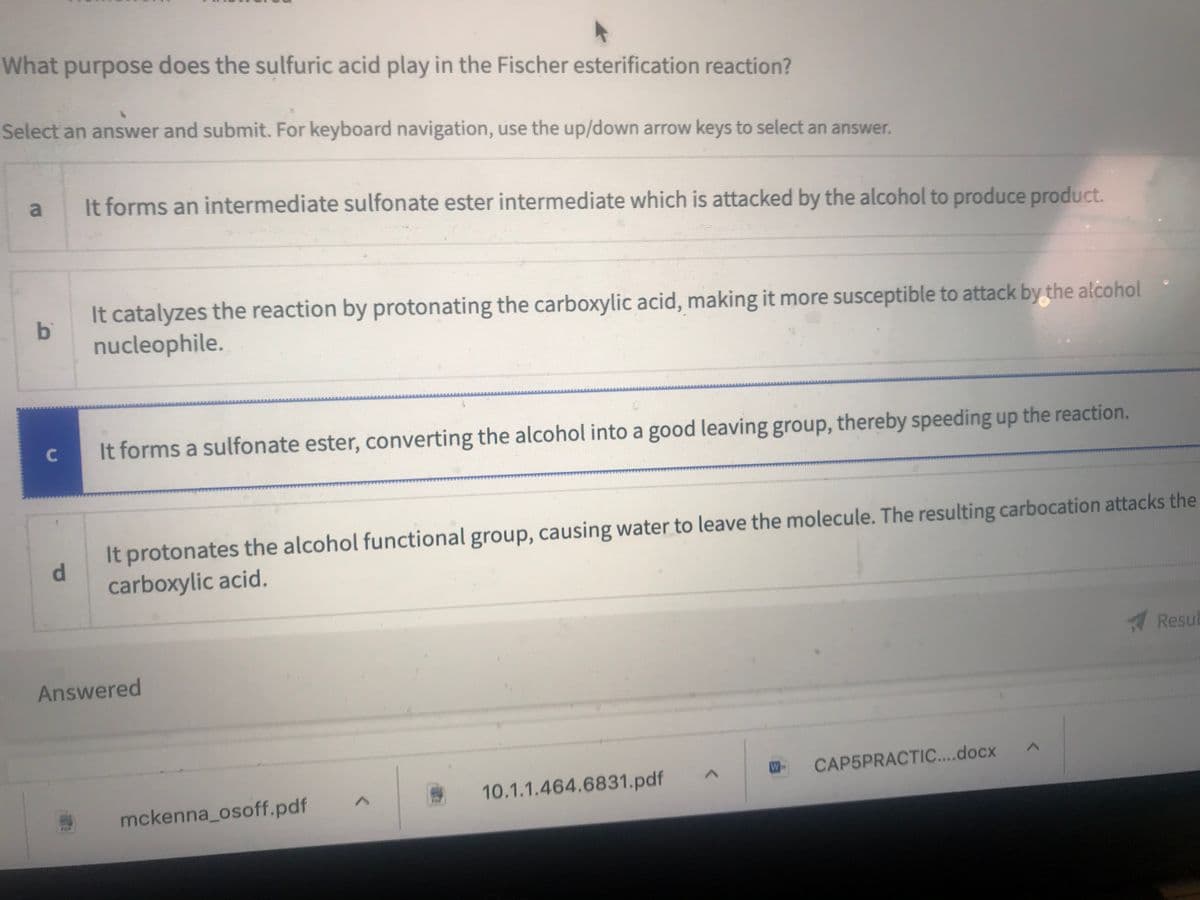at purpose does the sulfuric acid play in the Fischer esterification reaction? ect an answer and submit. For keyboard navigation, use the up/down arrow keys to select an answer. It forms an intermediate sulfonate ester intermediate which is attacked by the alcohol to produce product. It catalyzes the reaction by protonating the carboxylic acid, making it more susceptible to attack by the alcohol b nucleophile. It forms a sulfonate ester, converting the alcohol into a good leaving group, thereby speeding up the reaction. C It protonates the alcohol functional group, causing water to leave the molecule. The resulting carbocation attacks the carboxylic acid. Resul
at purpose does the sulfuric acid play in the Fischer esterification reaction? ect an answer and submit. For keyboard navigation, use the up/down arrow keys to select an answer. It forms an intermediate sulfonate ester intermediate which is attacked by the alcohol to produce product. It catalyzes the reaction by protonating the carboxylic acid, making it more susceptible to attack by the alcohol b nucleophile. It forms a sulfonate ester, converting the alcohol into a good leaving group, thereby speeding up the reaction. C It protonates the alcohol functional group, causing water to leave the molecule. The resulting carbocation attacks the carboxylic acid. Resul
Introductory Chemistry: An Active Learning Approach
6th Edition
ISBN:9781305079250
Author:Mark S. Cracolice, Ed Peters
Publisher:Mark S. Cracolice, Ed Peters
Chapter22: Biochemistry
Section: Chapter Questions
Problem 68E
Related questions
Question

Transcribed Image Text:What purpose does the sulfuric acid play in the Fischer esterification reaction?
Select an answer and submit. For keyboard navigation, use the up/down arrow keys to select an answer.
It forms an intermediate sulfonate ester intermediate which is attacked by the alcohol to produce product.
It catalyzes the reaction by protonating the carboxylic acid, making it more susceptible to attack by the alcohol
bi
nucleophile.
It forms a sulfonate ester, converting the alcohol into a good leaving group, thereby speeding up the reaction.
It protonates the alcohol functional group, causing water to leave the molecule. The resulting carbocation attacks the
d.
carboxylic acid.
Resub
Answered
W
CAP5PRACTIC....docx
10.1.1.464.6831.pdf
mckenna_osoff.pdf
POR
Expert Solution
This question has been solved!
Explore an expertly crafted, step-by-step solution for a thorough understanding of key concepts.
This is a popular solution!
Trending now
This is a popular solution!
Step by step
Solved in 2 steps with 1 images

Knowledge Booster
Learn more about
Need a deep-dive on the concept behind this application? Look no further. Learn more about this topic, chemistry and related others by exploring similar questions and additional content below.Recommended textbooks for you

Introductory Chemistry: An Active Learning Approa…
Chemistry
ISBN:
9781305079250
Author:
Mark S. Cracolice, Ed Peters
Publisher:
Cengage Learning

Organic Chemistry
Chemistry
ISBN:
9781305580350
Author:
William H. Brown, Brent L. Iverson, Eric Anslyn, Christopher S. Foote
Publisher:
Cengage Learning

Chemical Principles in the Laboratory
Chemistry
ISBN:
9781305264434
Author:
Emil Slowinski, Wayne C. Wolsey, Robert Rossi
Publisher:
Brooks Cole

Introductory Chemistry: An Active Learning Approa…
Chemistry
ISBN:
9781305079250
Author:
Mark S. Cracolice, Ed Peters
Publisher:
Cengage Learning

Organic Chemistry
Chemistry
ISBN:
9781305580350
Author:
William H. Brown, Brent L. Iverson, Eric Anslyn, Christopher S. Foote
Publisher:
Cengage Learning

Chemical Principles in the Laboratory
Chemistry
ISBN:
9781305264434
Author:
Emil Slowinski, Wayne C. Wolsey, Robert Rossi
Publisher:
Brooks Cole